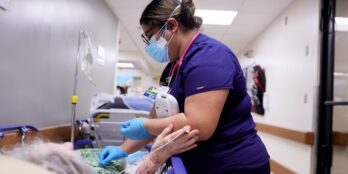
Addressing the Unique Challenges of Workplace Violence in the Healthcare Sector
 5 min
5 min
A Safer Environment for Healthcare Professionals is a Must
Workplace violence is a significant issue for all healthcare and social service providers.
The healthcare sector faces unique challenges that make it more vulnerable to violence. Factors such as the opioid epidemic, behavioral and mental health conditions, financial stressors, overcrowded and chaotic emergency departments (EDs), and gaps in care for those struggling with complex chronic conditions all contribute to this increased vulnerability. In addition, certain medical conditions — including COPD (Chronic Obstructive Pulmonary Disease), Alzheimer’s, Parkinson’s, epileptic seizures, and hormonal imbalances — can also predictably contribute to a higher risk for violence, as can age and gender.
The Occupational Safety and Health Administration (OSHA) reports that an alarming 75% of all reported workplace assaults occur in healthcare and social service settings. It is particularly disturbing to know that frontline workers, dedicated to helping others, face such a substantial risk of harm while on the job. In addition to the trauma of a healthcare provider enduring an attack while working, there are increased costs that are associated with these events as well.
The American Hospital Association reports that the United States spends approximately $43 million in medical care and lost wages each year for workplace violence events. This does not include the cost to replace a nurse if they choose to leave the profession due to post-traumatic stress or feeling unsafe. The average cost to replace a nurse in the United States is currently around $65,000. As one can see, a workplace violence program must include prevention, alerting, mitigation, event response, and reporting of data. By addressing these challenges head-on and implementing comprehensive safety measures, we can create safer working and care environments.
The Substance Use Disorder Crisis Exacerbates the Situation
The Journal of Substance Abuse Treatment observed that patients receiving treatment for substance use disorder had a 75% higher reported history of committing violent acts while under the influence. In fact, psychiatric departments have the highest rates of clinical staff falling victim to workplace violence. Considering that studies suggest only 21% of instances of violence are actually reported, the number of patients committing violent acts while under the influence is likely higher than that.
Because of this strong correlation between substance use disorder and patient violence, we know that as the epidemic of substance abuse continues, so will the acts of violence. Without the appropriate resources and training to address and prevent these attacks and de-escalate agitated patients, hospital staff will be ill-prepared to handle patients in a state of delirium from substance use or withdrawal.
Swift Response to Violence is Critical
Studies illustrate that 83% of physicians and 78% of nurses have been victims of verbal abuse, which can lead to reduced job satisfaction, increased turnover, and psychological impacts — including depression, sleep disorders, and post-traumatic stress disorder. All of these hurt the clinician and result in decreased quality of care for the patient.
By having an automated solution that provides real-time alerts within the staff workflow, there can be a shortened response time by those trained to properly handle and de-escalate a serious situation. These real-time alerts can increase awareness and prevent disruption or destruction of hospital property, all while improving the safety of staff, patients, and visitors.
Automated, real-time alerts are also important for mitigating the impact of violence during off-hours — such as 4:30 a.m. on a Sunday — when there are less resources and staff available. It is observed that 60% of instances of workplace violence take place during night shifts or on weekends. Building workplace safety and prevention programs to accommodate the sparse conditions of those shifts is crucial to a program’s overall success and outcome.
Additionally, when workplace violence occurs, having a way to quickly communicate between care team members, hospital security, and the community can shorten the time providers are exposed to an assault.
Learning to Predict and Prevent Violence With Limited Resources
While the adage states that “prevention is the best medicine,” prevention is also the best method to avoid the lasting effects of a workplace violence event. Our best chance for helping patients and the healthcare providers that care for them lies in predicting and preventing violence before it ever happens.
When hospital staff can connect with other members of a patient’s care team and view pertinent patient info beyond the perfunctory medical history completed during the intake process, they will be able to identify potential patterns for violence, even if violence has not been reported previously in the patient history. Able to recognize these patterns, care teams can then take precautions to prevent triggering a violent episode.
When providers have the resources they need to quickly access insights about patient patterns and potential threats, both patient and provider well-being improves. Technology solutions that can streamline communication and give care teams a more advanced awareness of each patient can help empower clinicians to provide safer and more informed care — no matter where they practice.
November 6, 2023






